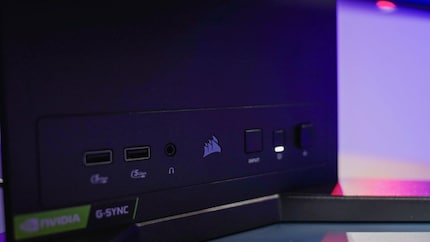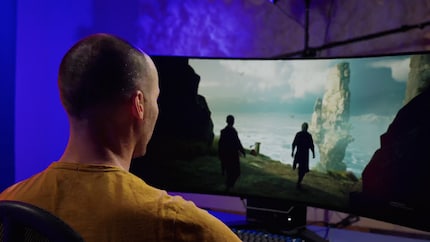
A quick Corsair Xeneon Flex test: cool, but has too many flaws
You can curve Corsair’s OLED gaming monitor yourself. Quite the feature, but it isn’t enough to recommend a purchase.
The 45-incher from Corsair (the manufacturer, not the pirate) bends at your behest. It can be manually curved from flat to 800R. If the monitor were to form a circle with this curvature, its radius would be 800 millimetres. This makes it suitable for office work and gaming. Personally, I like a flat monitor when working and prefer a bend for gaming. The former doesn’t warp windows while the latter draws me more into the action. I’ll tell you how useful the feature is in the video. This is only available in German, however you can activate English captions under Subtitles > Auto-translate. If you don’t want to watch it, I’ll summarise my main thoughts about the monitor here.

For my test, I used this PC from Captiva.
A resounding eh
The bending feature works – halfway. To curve the monitor, I have to push a button to unlock two levers on the back. It’s so fiddly and gets on my nerves by the third time. I’m not really comfortable with the bending itself, even after many uses. It’s creaky, and when I reach the maximum curvature there’s an unpleasant clicking sound. I’m always afraid of breaking something. In addition, the Flex doesn’t flex evenly and doesn’t always stay locked in the desired curvature. Still, being able to adjust the bending degree is useful.

Source: Manuel Wenk/Davide Arizzoli
The positive
The Xeneon Flex can’t be adjusted in height, but it can be tilted. Thus, it fulfils at least one important ergonomic criterion. But there’s a good reason for why it can’t be height-adjusted: the monitor offers two USB 3.2 ports and a 3.5-millimetre audio output in the front of the stand. The controls are also located on the stand. In my eyes, this is a great feature and makes operation less fiddly than with models that have the controls on the monitor itself. The Flex also offers many other modern ports like HDMI 2.1 and USB Type-C with charging support up to 90 watts.

Source: Manuel Wenk/Davide Arizzoli
The monitor has a refresh rate of 240 hertz and is thus ideally suited for first-person shooters. Its response time of 0.3 milliseconds is also excellent. It’s wonderful to game with. There’s no screen tearing thanks to AMD Freesync Premium and Nvidia G-Sync.
The colours contrast well and look natural in dark images. As befits OLED, black really means black. However, brighter areas look a bit pale, which has to do with the meager brightness.
The negative
The peak brightness is 1000 nits. However, the monitor only achieves this in a small area or for a short time. Viewed over the entire panel, there’s only 150 nits. That’s not enough for me to work or game in a bright room. This requires at least 300 nits – 350 is even better.

Source: Manuel Wenk/Davide Arizzoli
The 3440 × 1440 pixel resolution is also weak in my eyes. Seen across the 45-inch screen diagonal, this results in a pixel density of 82 pixels per inch. On closer inspection, I feel like I can count the pixels.
Verdict: too much money for too few pixels
The bend feature sets the Xeneon Flex apart from other monitors. However, this alone isn’t enough for a recommendation. Personally, I find the feature handy when switching from working with a flat screen to gaming with a curved display. However, I doubt that I’d really use this in everyday life. Most likely, I’d adjust the monitor once and then just leave it as is.
The Flex simply offers too little pixel density for its size. 82 pixels per inch, that’s just too low. The image doesn’t look as sharp as I’m used to. Over 2000 francs/euros is just too expensive in my eyes. A shame, I otherwise like the monitor. Personally, if I want an OLED for gaming and I want it to be big, I’d go for a TV. Today, these also offer features like 120 Hertz or variable refresh rates and cost half as much. You’ll just have to do without the curvature.
From big data to big brother, Cyborgs to Sci-Fi. All aspects of technology and society fascinate me.



